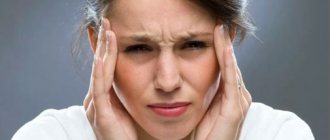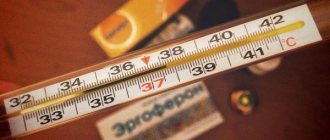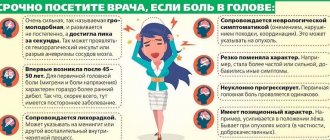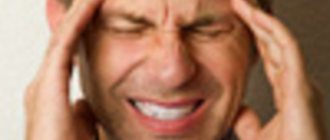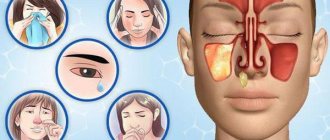10.11.2015
Maltseva Marina Arnoldovna
Head of the consultation department - neurologist, specialist in the field of extrapyramidal pathologies, doctor of the highest category
Shabunina Ekaterina Mikhailovna
Neurologist, category 2
Headache is one of the most common health problems. Every person has experienced a headache at least once in their life, but everyone describes this symptom differently, since the causes of its occurrence can be very different. In this article we will talk about a type of cluster headache, since this pathology is a serious problem for the patient and causes him significant discomfort, up to the development of a subdepressive state or even depression.
Types of headaches
In practical medicine, neurologists distinguish several types of headaches; this is very convenient for diagnosis and further development of a treatment plan. Headaches can be of four main types:
- Tension headache. The most common type of headache among all options. Tension headaches occur as a result of psychoemotional stress or high physical activity. This type of pain is functional in nature and does not have a pronounced intensity. Tension headaches most often go away on their own without the use of medication.
- Migraine-like headache. The etiological factor in the formation of migraine-like pain or migraine itself is neurological pathology of the central nervous system. Most often, migraines are caused by organic pathology of the brain, and migraine itself is manifested by characteristic attacks of headache localized only in the right or left hemisphere. Headache attacks are pulsating in nature and occur at certain time intervals. Thus, migraine has a paroxysmal course with periods of remission, which can reach up to 10-12 months.
- Chronic headache. A diagnosis of chronic headache is possible when more than 4 headache attacks per week are recorded for at least three months. Chronic headaches can occur as a result of a wide range of causes, but most often the main component in the formation of chronic headaches is impaired cerebral blood flow.
- Cluster headache is the rarest type of headache, but the most dangerous for the patient. Cluster headache is considered the most intense and severe among all its types.
Why do cluster headaches develop?
The role of heredity in this disease is not excluded, however, according to observational data, only about 5% of people took up this difficult baton from their close relatives.
The immediate cause of the development of cluster headaches is a violation of the regulation of vascular tone in the brain and head, due to disruption of the functioning of the nervous system, in particular the trigeminal nerve (thanks to which we perceive various sensations in the face) and the hypothalamus (an organ of the central nervous system that ensures changes in biological rhythms, in particular sleep and wakefulness).
What is a cluster headache?
Cluster headache or cluster cephalgia is a type of headache with a pronounced pain syndrome and a vivid clinical picture. This type of pain is considered idiopathic by many specialists, i.e. with unclear etiology. Cluster headache is also called cluster headache - both concepts are synonymous and do not differ in any way.
Cluster headaches in most cases are unprovoked and occur spontaneously. Patients experiencing this type of headache often report complaints of stabbing, burning and throbbing pain. The pain gradually increases and becomes literally unbearable; such pain can only be compared with renal colic or ischemic pain. As practice shows, ordinary analgesic drugs from the group of non-steroidal anti-inflammatory drugs turn out to be ineffective or completely ineffective, which requires hospitalization of the patient in a hospital.
Statistics show that men are almost six times more likely than women to suffer from cluster headaches, however, the causes of this statistical phenomenon have not yet been identified.
What causes a cluster headache?
It has been noted that a cluster period (see above) can occur after a disruption to the usual daily rhythm: changing time zones during air travel, sleepless nights, daily work schedule, etc. The attack itself can be triggered by taking alcohol or nitroglycerin.
It is important to note that during the period of remission (see above) no provocateurs are capable of causing an attack of cluster (cluster) headache.
Lion and mouse syndrome?
Experts have noticed that people suffering from cluster headaches have this syndrome. Thus, men with this form of headache have a characteristic appearance: an athletic, masculine physique, thickened facial skin with pronounced expression wrinkles (“lion face”). At the same time, they are characterized by internal constraint, indecisiveness, and often experience difficulties in making decisions (“heart of a mouse”).
Etiology and pathogenesis
To understand how to get rid of cluster headaches, you need to understand what pathological processes are behind the formation of this disease.
The causes of cluster headaches can be completely different. In most cases, it is not possible to identify any leading factor or organic damage to brain tissue. However, recent studies have shown that the most common cause of cluster cephalgia is:
- Pathology of the hypothalamic-pituitary system;
- Pathology of the reticular formation;
- Spasm of the cerebral arteries;
- Diseases of the sympathetic nervous system.
Patients often note the occurrence of pain during transitional weather conditions in the autumn and spring periods.
Cluster headache is a cyclical disorder and the development of the disease can be associated with disorganization in the functioning of circadian rhythms, i.e. biological clock of the body. Human circadian rhythms have a close relationship with the autonomic sympathetic and parasympathetic nervous systems. With the development of cluster headaches, there is a disruption in all these systems, i.e. the neurohumoral regulation of the body's autonomic functions is disrupted, such as vascular tone, secretion formation by the endocrine and exocrine glands, disruption of the sleep-wake cycle and many others.
Scientists have proven that when an attack of cluster cephalgia occurs in a patient, the secretion of histamine, an inflammatory neurotransmitter, in the blood increases significantly. Its concentration in the blood increases in proportion to the intensity of the headache attack. The inflammatory mediator histamine is a biologically active substance and has a vasodilating or vasodilating effect, which in turn leads to symptoms such as redness of the skin and hyperemia of the mucous membrane.
Cluster Headache – Frequently Asked Questions
What are the symptoms of the disease?
Basically it is pain: very severe, sudden, unilateral, usually localized in the orbit or temporofrontal region, lasting 15-180 minutes. In addition, the patient has increased excitability, he is restless, noisy, he may even be aggressive, he cannot sit or lie down, he is usually in motion all the time - he walks, he may also have thoughts of suicide, as well as the occurrence of lacrimation , redness of the conjunctiva, swelling and sagging of the eyelid, constriction of the pupil, runny nose, increased sweating of the forehead on the side of the affected orbit.
What are the risk factors for a pain attack?
Alcohol, regardless of strength and even in small quantities, smoking, high blood pressure, stress, watching TV, staying in high temperatures, taking drugs such as nitroglycerin, i.e. releasing nitric oxide in the body, staying in high altitude conditions.
Where should I go to effectively treat this disease?
In case of severe general symptoms, the patient should first consult a physician. During your visit, you should accurately describe your symptoms and the circumstances under which they appeared, as well as the presence of factors that aggravate them. Then the family doctor, having the results and a detailed description of the medical examination, will refer us to a specialist doctor - a neurologist, he is almost always the attending physician, although consultations with doctors of other specialties may be required throughout the entire process of diagnosis and treatment.
What tests do I need to do?
Diagnosis includes: history, physical examination, including neurological examination and imaging.
Bibliography
- Prusinski A., Cluster headache, PZWL, Warsaw, 1993;
- Prusinski A., Headaches in primary health care practice, Przew Lek 2004;,
Vorobyova Marina
Neurologist of the highest qualification category (work experience 14 years), doctor of neurofunctional diagnostics (work experience 12 years); author of scientific publications on vertebroneurology; participant of scientific conferences on neurology and functional diagnostics of all-Russian and international significance.
Types of cluster pain
Within cluster cephalgia itself, two main clinical variants of the course of the disease can also be distinguished. They are classified according to the nature of the attacks:
- Episodic in nature. Such attacks overtake the patient constantly, they can occur up to 3-4 times a week and last for months, after which they suddenly pass and may not bother the patient for years.
- Chronic cluster headaches. Painful attacks occur on a regular basis and last for more than a year. The intensity of the pain syndrome in the chronic form may be somewhat lower, and the frequency of attacks is less. The chronic form is registered in no more than 20% of patients.
What types of cluster headaches are there?
Taking into account the characteristics of the manifestations of this type of pain, it is customary to divide it into two types:
- Episodic, when cluster periods (bundles), that is, periods when attacks of characteristic headaches occur, last from a week to 1 year with remissions, or periods of absolute health, which last 1 month or more (on average 2-3 years).
- Chronic, when cluster periods are not replaced by remissions (10-15% of those suffering from this disease), or remissions last less than 1 month.
Clinical picture
Despite the fact that the main symptom of cluster cephalgia is pain, the disease is manifested by a number of additional characteristic symptoms. The main role in the formation of the clinical picture is played by autonomic disorders of the sympathetic nervous system, which manifest themselves:
- Severe lacrimation;
- Hyperemia or redness of the skin of the face and mucous membranes of the eyes;
- Nasal congestion;
- Increased salivation.
In addition to the symptoms described above, it is important to note that the pain has a clear localization. Most patients describe an area of pain in the area of the left or right eye, and the pain manifests itself only in one half of the head. Patients note the most intense pain in the eye or behind the eye; pain can also spread to the face, temporal region, forehead and neck. Pain is least often observed in the occipital region.
Cluster cephalgia looks like this:
- Headache occurs without any external or internal warning signs;
- Most often, cluster headaches occur at night, during night sleep.
- The intensity of the painful attack increases quickly, but lasts no more than 2-3 hours.
- Repeated attacks of cluster headaches may occur on the same day and continue to appear for several weeks, after which they subside. From this we can conclude that cluster pain is serial in nature.
- The remission period can last from six months to several years.
It can be noted that pain always appears at the same time, this indicates functional disorders in the patient’s circadian daily rhythm. When examining the cardiovascular system during an attack, the patient has a rapid heartbeat (tachycardia) and increased blood pressure, but the numbers increase slightly.
Symptoms
Cluster headaches occur at the same time, 1-3 times a day (in some patients they can occur once every 2 days, in others - up to 8 times a day). Often an attack causes a person to wake up at night. Painful sensations increase over 5-10 minutes and can last from 15 minutes to 3 hours (usually 30-90 minutes).
The nature of the pain is burning, stabbing, throbbing or pressing. It is stronger and more painful than a migraine. The patient cannot sit still and walks back and forth. The attack can be so severe that during it the person contemplates suicide.
Pain is localized on one side, usually behind and around the eye, spreading to the temple, forehead, cheeks, nose, and upper jaw.
Symptoms that may occur during an attack on the side of pain:
- drooping eyelid;
- redness of the eye;
- constriction of the pupil;
- half of the nose is stuffy;
- lacrimation;
- swelling, sweating on half of the face.
As a rule, a series of attacks lasts for weeks or months, and then disappears completely for a while, after which they return again.
We will call you back, leave your phone number
Message sent!
expect a call, we will contact you shortly
Similar features of patients
Scientists noted a dependence between the identification of patients suffering from cluster headaches and metric body parameters. Most of the studied patients had similar physical and metric parameters. Thus, among the patients, most often there are middle-aged men from 25 to 40 years old, with a strong muscular build. Characteristic facial features are also noted: an almost square lower jaw, a cleft chin and a light shade of eyes. More than 90% of patients note that they smoke, and the intensity of smoking is quite high, reaching up to one and a half packs of cigarettes per day.
Treatment strategy for cluster headaches
- Therapy begins with identifying the cause of the problem.
- After testing, the doctor’s task is to stop the attack and eliminate the pain syndrome.
- Preventive measures are prescribed to prevent relapses.
Treatments include paraffin therapy, injections of drugs for migraine pain and lidocaine drops in the nose. Inhalations have worked especially well.
Inhalations can be conveniently performed using lightweight, compact and low-maintenance oxygen concentrators of the jay 3a and 5a mini models.
To get rid of cluster pain that occurs due to apnea and other reasons, CPAP therapy is usually used. Its main principle is the creation of positive dosed pressure in the airways. It maintains the tissues of the nasopharynx and palate in the desired position, which prevents them from collapsing and prevents breathing from stopping.
Important!
Today, CPAP is used by more than 80% of patients. They note the rapid and effective effect of such therapy.
It happens that it is impossible to cope with the problem with medication. Then the following methods are used, including surgical interventions:
- Electrical brain stimulation
- Stimulation of the occipital nerves and vagus nerve
- Removing or blocking the facial nerve
- Trigeminal nerve decompression
The prevention program includes establishing a healthy lifestyle, attending stress reduction and relaxation training, moderate exercise, and avoiding alcohol and smoking.
Diagnostics
It is quite difficult to diagnose cluster headache, since apart from complaints and minor clinical manifestations, it is extremely difficult to register this form of the disease. Since the etiological factor is often idiopathic, the examination should be as broad as possible. First of all, the specialist records all the patient’s complaints and also enters the medical history data into the medical history, after which the patient is prescribed a set of laboratory and instrumental diagnostic tests.
The patient must undergo tests such as:
- General blood analysis;
- Biochemical blood test, which includes a study of the blood lipid profile;
- Coagulogram;
Of the instrumental research methods, the patient is prescribed:
- X-ray research methods, such as computed tomography and magnetic resonance imaging. In some cases, contrast enhancement of the cerebral arteries is used;
- Ultrasound color duplex scanning of the carotid and cerebral arteries;
- Fundus examination.
- Polysomnography is a comprehensive study of sleep quality, which includes electrooculometry, electroencephalography, electrocardiography, myometrium, blood saturation with oxygen and carbon dioxide, as well as video recording of sleep.
Specialists such as a therapist, ophthalmologist, neurologist and psychotherapist must be involved in examining a patient with suspected cluster headache.
Only after a complete study of the symptoms of cluster headaches and an examination can treatment tactics be formed.
How is a cluster headache treated?
The main recommendation for treating this headache, as in general for any other disease, is to avoid self-medication and consult a doctor (neurologist).
There are treatments for the immediate attack of cluster headaches and preventive (interictal) treatment.
How is an attack of cluster headache treated? The most commonly used medications are:
Triptans (Sumatriptan, Zolmitriptan) in the form of tablets or spray for irrigation of the nasal cavity. Under their influence, a headache attack is relieved on average 10-15 minutes after the start of treatment;
Dihydroergotamine (spray for irrigation of the nasal cavity - Dihydrergot or solution for injection). Effect 10-15 minutes after administration.
An ice-cold 4% lidocaine solution may also be effective. To instill it into the half of the nose similar to the side of the headache, the person is asked to lie on his back, with his head turned 30° towards the headache.
Another possible way to stop an attack is mask inhalation of 100% oxygen. The recommended inhalation volume is 7 l/minute for 10 minutes. About 60-70% of patients respond to this therapy. However, in some cases, oxygen can only weaken, but not completely stop, an attack. Its disadvantage is that it is difficult to use at home.
Treatment tactics
Treatment of cluster headache is a pressing issue that is being actively studied in modern neurological practice. Optimization of treatment regimens and principles allows you to achieve lasting and effective results. At the moment, there are two independent and mandatory treatment approaches for each patient. The first approach is analgesic symptomatic therapy aimed at symptomatic treatment, i.e. relief of an acute attack of cluster headache. The second principle is preventive treatment to prevent recurrence of a series of attacks of cluster pain. Unfortunately, it is currently impossible to completely cure the disease, however, with supportive corrective therapy, lasting results can be achieved.
Anesthesia
Analgesic therapy consists of prescribing potent analgesic drugs with a central mechanism of action. Such drugs belong to the group of narcotic drugs and are used only for treatment in a hospital setting. The use of pure oxygen has also shown high effectiveness in relieving an attack of cluster pain. During an attack, the patient is given 100% oxygen by inhalation, which reduces the intensity of the pain syndrome.
Prevention
Prevention of cluster headaches involves the use of complex therapy aimed at improving the rheological properties of the blood, maintaining the cardiovascular and nervous system, as well as the use of glucocorticosteroids.
They use drugs from the group of angioprotectors and neuroprotectors, which significantly increase the metabolic activity of the brain and prevent dystrophic disorders in the central nervous system. Lithium preparations are also used to improve the functioning of the hypothalamic-pituitary system and normalize electrochemical and neurotransmitter processes in the brain.
Clinical Brain Institute Rating: 4/5 — 16 votes
Share article on social networks
New hopes in the treatment of cluster headaches.
A study of a new electrical stimulation device for the treatment of cluster headaches has begun in the United States. We asked Joshua Cohen, MD, MPH, a neurologist at the Headache Institute and Icahn School of Medicine at Mount Sinai in New York, to talk about this devastating disease and a device that could help treat it.
Cluster headache
affects about 0.1% of the population, it is also called “suicidal headache” due to the incredible severity of the headache and leading to tragic consequences. The name of this disease comes from the English word 'cluster' - “bundle” or “grouping” and implies the concentration of pain in one place. Women who have given birth say that the nature of pain during childbirth is nothing compared to cluster headaches. But most often men suffer from this condition.
Cluster piercing headache usually occurs in the depths of the periorbital region or in the frontal region. As a rule, it is accompanied by unilateral autonomic disorders: ptosis, miosis, redness of the eye, lacrimation, runny nose, nasal congestion, sweating. Patients become restless, run around the room, or may even hit their head against the wall.
Each episode lasts from 15 to 180 minutes, but quite often. These pains are also called “alarm clock” because during the cluster period the pain appears at the same time every day, sometimes several times a day. In addition, these pains have a regular seasonality: usually occur in the fall or spring.
All these pains most likely have a connection with the hypothalamus, which regulates the circadian rhythm.
There are 2 types of cluster headaches. Episodic cluster pain
- the duration of attacks can be from 7-365 days a year, after which a period of remission follows about 1 month or more.
80-90% of patients have episodic cycles. Chronic cluster headache
- may last more than 1 year or the period of remission is less than 1 month. It is observed in 10-15% of patients. Interestingly, these forms can suddenly transform into one another.
TREATMENT
There are 3 main methods of treatment: acute therapy, intermediate (short-term) and preventive.
Acute therapy is based on timely relief of the attack. The two most effective methods are: injection of triptan, which relieves an attack within 5-15 minutes; and inhalation through a mask with 100% oxygen.
Intermediate (short-term) therapy is based on preventing attacks for months or years. Steroids are commonly used as bridging therapy. A 10-14 day course of prednisone can have significant success.
For people with chronic cluster pain, preventive procedures are usually used. The most commonly used is verapamil.
Other effective drugs include topiramate, valproic acid, and lithium. But these drugs have many side effects. Patients using these drugs should be monitored for signs of depression and changes in behavior.
If all these methods are ineffective, surgical intervention remains to relieve the unbearable suicidal headache.
Currently, the first-line surgical procedure is occipital nerve stimulation.
A more invasive form of surgery is deep electrical brain stimulation.
when electrodes are placed in the hypothalamus. This surgery has shown promising results, although there are risks associated with placing electrodes in the brain.
NEW!! Stimulation of the parasympathetic pterygopalatine ganglion
A new electrosimulator is currently being implanted behind the upper jaw, which patients can turn on or off themselves. A short electrode is applied to the pterygopalatine ganglion, which is responsible for the sensory and autonomic functions of the face.
Last year, at the International Headache Congress, European researchers showed the significant effect and safety of this device in the management of cluster pain. The device is already on sale in Europe.
Although further studies with larger sample sizes and long-term results are needed, this new device may offer hope to people suffering from unbearable headaches.
Results from the main trials will be available in 2015.
Guest Blog: New Hope for Cluster Headache Published: Aug, 2014
Programs:
Headache
Electronic application
Parkinson's disease, parkinsonism and other extrapyramidal pathologies
Treatment of dizziness
Laboratory diagnostics
Cluster headache
What is a cluster headache?
“The pain often wakes me up in the middle of the night, 1-2 hours after falling asleep.
It grows within a few seconds and becomes unbearable and painful. Only the right eye hurts, which becomes very red and looks like a “hot poker.” At this moment I can't find a place for myself. I have to do something to get rid of the pain. Sometimes I walk back and forth around the room, holding my head, sit down and get up again, sometimes I rock in my chair.” Cluster headaches (PHBs) are characterized by short attacks of extremely intense unilateral pain in or around one eye. Typically, PHB occurs suddenly, one or more times a day, usually at the same time of day and/or night. Often the first attack begins at night and wakes a person 1-2 hours after falling asleep.
PHB is sometimes called a variant of migraine, but this is incorrect. This is a special form of headache that requires completely different treatment.
Who suffers from cluster headaches?
Cluster cephalgia is a rare disease (occurs in approximately 3 people out of 1000). PHB is 5 times more common in men, unlike most other forms of headache, where women predominate. As a rule, the first attack occurs between the ages of 20 and 40 years, but the onset of PHB can occur at any age.
What types of PHB are there?
Episodic cluster headaches are the most common. This form is characterized by alternating periods of pain, during which attacks of excruciating headaches (pain “bundle” or “cluster”) occur every day and night, and periods without headaches (remissions). Usually the pain bundle lasts from 6 to 12 weeks, it can end in 2 weeks, it can last up to 6 months. Painful periods, as a rule, are seasonal, i.e. occur at the same time of year (usually in spring and autumn); Some patients experience 2-3 periods of pain per year, others may have long-term remissions (for 2-3 years). Outside the cluster period, patients with episodic PHB do not have any symptoms.
Chronic cluster headache is characterized by daily, or almost daily, headache attacks that continue from year to year, without clear intervals; the frequency of chronic PHB does not exceed 10%. Episodic PHB can become chronic and vice versa.
What are the symptoms of PHB?
The symptoms of PHB are well recognized. One of the main symptoms is the excruciating, unbearable nature of the pain. The pain always occurs on one side; Rarely, in episodic PHB, the side of pain may change from one painful period to another. The pain is localized around or in the eye area and is described as burning, stabbing, or boring. The pain increases rapidly, reaches a maximum within 5-10 minutes and, if left untreated, lasts from 15 minutes to 3 hours (on average 30-60 minutes). Unlike a migraine attack, during which most patients tend to lie down and remain as calm as possible, patients with PHB, on the contrary, cannot sit or lie down and become agitated and restless.
Also, on the pain side, most patients experience redness of the eye, lacrimation, swelling, and sometimes drooping of the upper eyelid. There may be nasal congestion or clear nasal discharge on the side of the pain. At the same time, the other side of the head does not bother the patient at all.
What are the causes of PHB?
Despite a large amount of research, the cause of PHB remains unclear. It is believed that the rhythmic occurrence of painful periods is associated with the activity of the hypothalamus, an area of the brain called the “biological clock” that determines the change in biological and circadian rhythms in the human body.
An interesting fact is that most patients with cluster headaches are heavy smokers or have smoked in the past. How smoking may contribute to the occurrence of PHB is still unknown. Quitting smoking is always beneficial for health, but rarely has any effect on the course of PHB.
What factors provoke PHB?
Knowing your triggers can help you avoid a headache attack. Alcohol, including in small quantities, can provoke an attack of PHB during the cluster period, but during the period of remission, alcohol is not a provocateur. It is unknown how this happens. Other trigger factors are unknown.
Do you need additional examinations?
Because of its characteristic symptoms, cluster headaches are easily recognized. Currently, there are no examination methods confirming the diagnosis of PHB. Diagnosis is based on your description of the characteristics of the headache and accompanying symptoms, and it is imperative that there are no abnormalities on medical examination. Try to describe your headache to the doctor in as much detail as possible.
If your doctor is unsure of the diagnosis, he may prescribe additional tests, including neuroimaging (computed tomography or magnetic resonance imaging), to rule out other causes of headaches. As a rule, this is not often necessary. If your doctor has not prescribed additional tests, this means that he is confident in the diagnosis and conducting examinations will not in any way make it easier to prescribe treatment.
What treatment methods are there?
There are several effective treatments for PHB; they all require a doctor's prescription. To stop attacks, the most effective method is inhalation of 100% oxygen, which requires special equipment, including a mask, a flow and O2 concentration dispenser, and an O2 reservoir. Injections of the drug sumatriptan are also used, which you can do yourself using a special injection device. Other forms of triptans are less effective, but can also be used to relieve an attack of PHB.
Preventive treatment is one of the most effective methods to combat PHB. To prevent cluster headache attacks and reduce the duration of the cluster period, medications should be taken daily for the entire duration of the headache. Preventive therapy is effective in most patients, however, it requires careful medical supervision, including monitoring of blood tests, due to the possibility of side effects. The therapist or neurologist you contact when pain begins may refer you to a headache specialist, since, due to the excruciating nature of the pain, patients with PHB should receive specialized care.
What to do if therapy is ineffective?
There are several medications available for preventive treatment. If one is ineffective, another can be used; sometimes combinations of two or more drugs are used.
What can you do to help yourself?
Conventional analgesics do not work for cluster headaches: they act too slowly, and the headache has time to develop before the analgesic effect occurs. For correct and successful therapy, you need medical advice. Try to see a doctor at the very beginning of the pain period, because the earlier treatment is started, the higher its effectiveness.
Keeping a headache diary
Keeping a diary will help you collect important information about headaches: how often the headache occurs, when it occurs, how long the headache lasts, and what symptoms accompany it. This information is very valuable for making a correct diagnosis, identifying factors that provoke headaches and assessing the effectiveness of treatment.
Can PHB be cured?
PHB can recur over many years. However, most people experience improvement with age (a decrease in the number of cluster periods or their cessation), this is especially true for chronic cluster headaches.
To learn more about the problem of headaches, visit the sites:
- migraine.net
- headache-society.ru
Read also
Planning pregnancy in patients with migraine
In recent years, many women suffering from migraine have turned to the prevention and treatment of migraine during pregnancy.
Conscious responsibility for one’s health, the desire to reproduce healthy… Read more
Overuse headache (Headache caused by excessive medication)
Frequent headaches are a good reason to immediately contact a neurologist. Otherwise, you can miss the onset of a serious illness or lead yourself to the formation of an abusive headache...
More details
Monoclonal antibodies against migraine
About 11% of people in the world suffer from migraines, and a third of them are forced to stay in bed during attacks. This significantly reduces the quality of life: it interferes with work, communicating with friends and engaging in hobbies.…
More details
Headache due to neuralgia of the greater occipital nerve
Headache caused by neuralgia of the greater occipital nerve occurs in 40% of patients. This is a signal from the body about the presence and development of serious problems. Unpleasant sensations are often confused by sufferers...
More details
Migraine
Migraine or headache seriously worsens a person's condition, especially with frequent attacks - chronic migraine. At the same time, people often do not take migraine seriously, not even thinking about seeing a doctor.…
More details
WHEN YOU SHOULD SOUND THE ALARM, THE FIRST SYMPTOMS OF CLUSTER HEADACHE
The headache quickly grows, the eye turns red and the person, in excitement, looks for a place - rushes about, walks in circles, “wants to bang his head against the wall”, holds his head in his hands, sways, moans, cries, screams... Horner's syndrome - ptosis (drooping) may often be present. eyelids), miosis (constriction of the pupil) and enophthalmos (recession of the eyeball). Such severe pain can cause thoughts of suicide.
Cluster headaches occur in series (bundles, clusters) of several attacks, from 15 minutes to an hour and a half, per day, with small rebounds and a subsequent increase in pain to the most severe, over the course of weeks and months, followed by long-term remission - months, years. There is a chronic form of cluster headache in which there is no remission. The most severe headaches occur at night and always appear at the same time.
There are no harbingers (aura). The patient wakes up from severe pain. The side of pain does not change during one beam, but in the future, in different episodes, a change of side is possible. At the beginning and end of the cluster period, attacks are less intense and can last several minutes. Further, the attacks become more severe and the pain is very intense and painful. During the intercluster period, a person feels healthy.
Cluster headache can be called a cyclical disorder associated with a person's biological clock. In the developmental mechanism, which has not yet been precisely studied, a major role is played by the hypothalamus, pterygopalatine ganglion, trigeminal nerve, and vasoactive substances - serotonin and histamine. As a result of complex neurohumoral, neurophysiological and cyclic processes, pathological vasodilation develops. It is precisely this phase of pain development that the treatment is aimed at - it is necessary to narrow the blood vessels and the attack will be stopped. The trigeminal nerve is the main conductor of pain. The autonomic symptoms of an attack are provided by the parasympathetic nervous system - parasympathetic fibers from the superior salivary nucleus to the pterygopalatine ganglion and then provide innervation to the vessels of the brain, lacrimal glands and glands of the nasal mucosa. During an episode of pain, alcohol and nitroglycerin can trigger an attack. Changes in the usual lifestyle can accelerate the emergence of a new cluster: a change in work schedule, a change in climate zone, neuro-emotional stress...
Such a severe headache immediately brings the patient to a neurologist.
